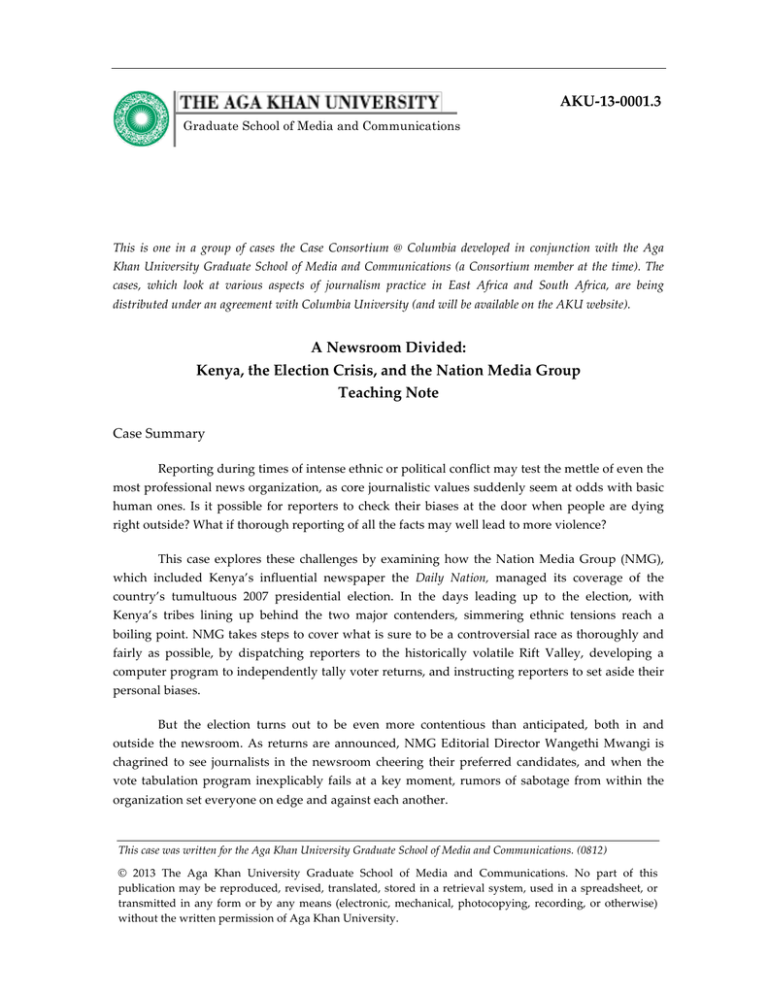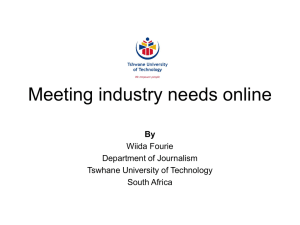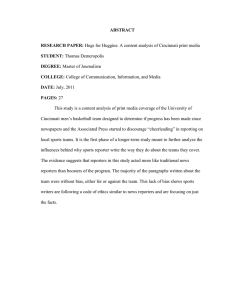AKU-‐‑13-‐‑0001.3 A Newsroom Divided: Kenya, the Election Crisis
advertisement

AKU-­‐‑13-­‐‑0001.3 Graduate School of Media and Communications This is one in a group of cases the Case Consortium @ Columbia developed in conjunction with the Aga Khan University Graduate School of Media and Communications (a Consortium member at the time). The cases, which look at various aspects of journalism practice in East Africa and South Africa, are being distributed under an agreement with Columbia University (and will be available on the AKU website). A Newsroom Divided: Kenya, the Election Crisis, and the Nation Media Group Teaching Note Case Summary Reporting during times of intense ethnic or political conflict may test the mettle of even the most professional news organization, as core journalistic values suddenly seem at odds with basic human ones. Is it possible for reporters to check their biases at the door when people are dying right outside? What if thorough reporting of all the facts may well lead to more violence? This case explores these challenges by examining how the Nation Media Group (NMG), which included Kenya’s influential newspaper the Daily Nation, managed its coverage of the country’s tumultuous 2007 presidential election. In the days leading up to the election, with Kenya’s tribes lining up behind the two major contenders, simmering ethnic tensions reach a boiling point. NMG takes steps to cover what is sure to be a controversial race as thoroughly and fairly as possible, by dispatching reporters to the historically volatile Rift Valley, developing a computer program to independently tally voter returns, and instructing reporters to set aside their personal biases. But the election turns out to be even more contentious than anticipated, both in and outside the newsroom. As returns are announced, NMG Editorial Director Wangethi Mwangi is chagrined to see journalists in the newsroom cheering their preferred candidates, and when the vote tabulation program inexplicably fails at a key moment, rumors of sabotage from within the organization set everyone on edge and against each another. This case was written for the Aga Khan University Graduate School of Media and Communications. (0812) © 2013 The Aga Khan University Graduate School of Media and Communications. No part of this publication may be reproduced, revised, translated, stored in a retrieval system, used in a spreadsheet, or transmitted in any form or by any means (electronic, mechanical, photocopying, recording, or otherwise) without the written permission of Aga Khan University. TN: A Newsroom Divided ____________________________________________________ AKU-­‐‑13-­‐‑0001.3 With the declaration as winner of Mwai Kibaki, the incumbent and a member of the politically and economically dominant Kikuyu ethnic group, inter-­‐‑ethnic violence erupts across the country, and Mwangi and his team must turn their attention to the safety of their reporters, as well as the public at large. With the death toll escalating, NMG takes several controversial steps to protect its reporters and to avoid spurring further violence, including withdrawing its reporters from the Rift Valley, and self-­‐‑censoring the names of tribes alleged believed to be involved in specific altercations. Mwangi justifies these steps by arguing that safety must be NMG’s foremost concern, but to his dismay he realizes he is losing credibility among his staff as his every move is interpreted in light of his own tribal associations. Moreover, by opting to cover the violence but exclude key details (and all of the Rift Valley), NMG finds its credibility with the public slipping as it appears to be, at best, providing partial coverage and, at worst, covering up major crimes. Meanwhile, tensions in the newsroom reach a fever pitch, with journalists speaking in ethnic vernaculars to selectively exclude their colleagues and openly treating one another with suspicion. Editors suspect reporters’ biases are affecting not just their conversations, but also their ability to impartially report on the violence. With the trust of the public in NMG, NMG journalists’ trust in each other, and his own authority within the organization all at stake, the case concludes with Mwangi contemplating how to address the ethnic tensions that have infiltrated his newsroom and created this multifold credibility crisis. Colleagues suggest an urgent staff meeting, an idea that intrigues Mwangi but leaves him uncertain about details. Students are left to consider the merits and risks of holding such a meeting, as well as what conditions and objectives for the meeting could best help Nation Media Group address the internal and external crises it faces. Teaching Objectives Use this case to start discussions about covering conflict, especially racial or ethnic conflict; reporting on politics in general and elections in particular; bias among journalists, including how editors and managers should handle it; and how to manage credibility crises, in and outside the newsroom. By the end of the case, Mwangi is facing credibility challenges on several levels: his own authority is under threat; journalists are openly hostile and suspicious of one another’s work and motives; and the public’s trust in NMG to fairly and thoroughly cover the nation’s most pressing issues is waning. Students should put themselves in his place and consider what steps he could take to avert these crises. Ask them to consider the pros and cons of the proposed staff meeting. On the one hand, allowing staff members to voice their grievances in a safe and non-­‐‑judgmental environment could help them find solutions productively, and collectively. On the other hand, tensions are so high a meeting could quickly devolve into a shouting match, with Mwangi’s 2 TN: A Newsroom Divided ____________________________________________________ AKU-­‐‑13-­‐‑0001.3 authority further eroded. If the meeting should take place, what conditions and objectives will lead to the optimal result? Ask students to consider what the role of a news organization should be during times of violent conflict. Should it focus on promoting stability and peace, as NMG’s editorial guidelines seem to suggest, or on reporting the complete, unvarnished truth? Students should keep these broader questions in mind when analyzing Mwangi’s decisionmaking throughout the case. For example, he opts not to name tribes involved in specific altercations to avoid spurring further violence. But, as Mwangi’s critics point out, not naming names runs the risk of damaging NMG’s credibility, and worse, contributing to the conflict in the long term by concealing major crimes. Encourage students to consider the advantages and disadvantages of withholding information under these circumstances. If they feel it is not appropriate, are there circumstances under which it would be? You might also ask students whether any of Mwangi’s other decisions about how to cover the violence surrounding the elections raise concern, or if they would have done anything differently. For example, was withdrawing reporters from the Rift Valley the right choice? Why or why not? Did Mwangi and his team unduly prioritize the safety of reporters over other important objectives such as informing the public (potentially saving lives in the process)? A second major theme in the case is that of journalistic bias, especially in political reporting and during times of intense partisan or ethnic conflict. Is it realistic to expect journalists to remain neutral under the circumstances in this case? If not, how can both reporters and editors take steps to ensure that their own biases do not inflect their reporting? For example, ask students whether they believe it is appropriate for journalists to openly support either a candidate or a political party in the following contexts: in the privacy of their home or at the polls; in the professional environment of the newsroom; or at public events like rallies. Should news organizations have policies prohibiting open partisanship and, if so, are such steps likely to prevent bias from seeping into reporting? One facet of the bias issue is credibility: arguably, the appearance of bias is every bit as damaging to a news organization’s credibility as verifiable evidence of it would be, since both lead to the distrust of the public. Ask students what steps they believe a Kenyan news organization should take to prevent accusations of ethnic bias, whether under extreme conditions like those in this case or on a regular basis. After considering these general questions, focus students’ attention on the reporters’ behavior in this case: did reporters behave inappropriately and, if so, in what ways? Should they have concealed their preferences during the election itself, or resisted the temptation to resort to tribal vernaculars during its aftermath? Students should also consider editorial management of the growing ethnic tensions in the newsroom. Could Mwangi have done anything to defuse the 3 TN: A Newsroom Divided ____________________________________________________ AKU-­‐‑13-­‐‑0001.3 situation earlier, and if so, what? For example, should he have intervened at the first signs that reporters were openly supporting their preferred candidates during the election? This case also raises for discussion the credibility of sources. During periods of violent conflict, with partisan loyalties at their most extreme, verifying source information becomes even more essential than usual, just as it becomes more difficult. Students should consider the challenges faced by reporters in the field: how can they balance their own safety and the public’s need for thorough, accurate information, with the need to verify source information? What specific steps should they take to ensure that witnesses are not distorting the facts? Class Plan Use this case in a class/course on journalism ethics, editorial management, reporting conflict, ethnicity and race in journalism, or reporting elections and politics. Pre-­‐‑class. Help students prepare for class by assigning the following question: 1) Should Mwangi call the staff meeting or opt for a different approach? Justify your answer. Instructors may find it useful to engage students ahead of class by asking them to post brief responses (no more than 250 words) to questions in an online forum. Writing short comments challenges students to distill their thoughts and express them succinctly. The instructor can use the students’ work both to craft talking points ahead of class, and to identify particular students to call upon during the discussion. In-­‐‑class questions: The homework assignment is a useful starting point for preliminary discussion, after which the instructor could pose any of the following questions to promote an 80-­‐‑ 90 minute discussion. The choice of questions will be determined by what the instructor would like students to learn from the class discussion. In general, choosing to discuss three or four questions in some depth is preferable to trying to cover them all. a) What are the pros and cons of convening the staff meeting? List on board. b) If Mwangi convenes the meeting, what should be the conditions (e.g. who should be included and under what circumstances), and what should be the objectives? c) What might be some effective alternatives to calling the staff meeting that might help resolve the credibility crises, both inside the newsroom and in the eyes of the general public, that are facing NMG? 4 TN: A Newsroom Divided ____________________________________________________ AKU-­‐‑13-­‐‑0001.3 d) Consider Mwangi’s management decisions. Is there anything he could have done differently to prevent ethnic tensions from having a divisive effect on his staff? e) Is it appropriate for reporters to openly support particular parties or candidates in the newsroom? At home? In public? f) NMG editors begin to suspect their journalists are selectively reporting the news according to their ethnic loyalties. How should they handle this? Could they have taken steps earlier to prevent it in the first place? g) Is there anything Mwangi and his staff could have done differently to prevent NMG from losing credibility with the public? What general strategies might a Kenyan news organization adopt to avoid accusations of tribal bias, whether by the staff or the public? h) What steps should reporters covering the conflict take to verify information from sources? Do these steps differ from those they should normally take to verify source information? i) Consider Mwangi’s own credibility problem with his staff. The case notes that most decisions he made to ensure impartiality inflamed accusations of bias. What might he have done differently to prevent this? j) What should be NMG’s foremost objective in covering the violence surrounding the election: to report the facts as clearly as possible, or to avoid spurring further conflict? k) One of Mwangi’s most controversial decisions is to censor the names of the tribes believed to be involved in violent altercations. His naysayers argue this reduces journalism to diplomacy, but Mwangi defends the decision, saying it avoids spurring further violence. Who is right, and why? Might there be some middle ground? l) What strategies do you think are best for reporting on escalating violence without inciting it further? Is it ever appropriate to withhold information to this end? What kinds of information and under what circumstances? m) Mwangi and his staff make a controversial decision to pull reporters out of the Rift Valley for their own safety. Do you agree with this decision? What are the arguments for and against it? Suggested Readings Jamal Abdi and James Deane, “The Kenyan 2007 Elections and Their Aftermath: the role of media and communication,” BBC World Service Trust, policy briefing, April 2008. 5 TN: A Newsroom Divided ____________________________________________________ AKU-­‐‑13-­‐‑0001.3 SYNOPSIS: This report, commissioned by the BBC World Service Trust, provides a fine overview of the media environment in Kenya and the role the media played in the violence following the 2007 election. If instructors read only one supplementary document to prepare for this case, this should be it. Concise yet thorough, the report analyzes the role of mainstream media, including the Nation Media Group, as well as community and vernacular media, especially radio. It concludes that vernacular media did devolve into incendiary hate speech in some cases, but that in others it promoted peaceful resolution. The assessment of mainstream media is likewise mixed, with journalists themselves arguing that lack of resources and partisan influence in the newsroom led to a failure to uphold journalistic values during this period. http://downloads.bbc.co.uk/worldservice/trust/pdf/kenya_policy_briefing_08.pdf -­‐‑-­‐‑-­‐‑-­‐‑-­‐‑-­‐‑-­‐‑-­‐‑-­‐‑-­‐‑-­‐‑-­‐‑-­‐‑-­‐‑-­‐‑-­‐‑-­‐‑-­‐‑-­‐‑-­‐‑-­‐‑-­‐‑-­‐‑-­‐‑-­‐‑-­‐‑-­‐‑-­‐‑-­‐‑-­‐‑-­‐‑-­‐‑-­‐‑-­‐‑-­‐‑-­‐‑-­‐‑ Stephanie Gleason, “Going Public: should journalists express their political views on social networking sites?” American Journalism Review, December/January 2010. SYNOPSIS: This article focuses on a recent incarnation of an old question: to what extent is it acceptable or even preferable (as some argue) for journalists to be transparent about their own partisan leanings? While the article was written in response to recent policy changes at prominent US news institutions explicitly forbidding the expression of political bias on social networks, it rehearses the classic arguments for and against transparency: some argue that both objectivity and its appearance are more likely when journalists are not allowed to express their partisan preferences, and others respond that being transparent about these not only does not interfere with ethical journalism, but enhances it. The article provides good background for instructors who want to use this case to discuss bias in the newsroom. http://ajr.org/article.asp?id=4846 -­‐‑-­‐‑-­‐‑-­‐‑-­‐‑-­‐‑-­‐‑-­‐‑-­‐‑-­‐‑-­‐‑-­‐‑-­‐‑-­‐‑-­‐‑-­‐‑-­‐‑-­‐‑-­‐‑-­‐‑-­‐‑-­‐‑-­‐‑-­‐‑-­‐‑-­‐‑-­‐‑-­‐‑-­‐‑-­‐‑-­‐‑-­‐‑-­‐‑-­‐‑-­‐‑-­‐‑-­‐‑ Gerald Loughran, “Birth of a Nation: The Story of a Newspaper in Kenya,” I.B Tauris, 2010. SYNOPSIS: This recently published history of the Nation Media Group, by a former Nation senior editor and veteran journalist, provides excellent background for this case and additional reading for students and instructors interested in knowing more about the intertwining histories of modern Kenya and its most prominent news organization. -­‐‑-­‐‑-­‐‑-­‐‑-­‐‑-­‐‑-­‐‑-­‐‑-­‐‑-­‐‑-­‐‑-­‐‑-­‐‑-­‐‑-­‐‑-­‐‑-­‐‑-­‐‑-­‐‑-­‐‑-­‐‑-­‐‑-­‐‑-­‐‑-­‐‑-­‐‑-­‐‑-­‐‑-­‐‑-­‐‑-­‐‑-­‐‑-­‐‑-­‐‑-­‐‑-­‐‑ Frank Smyth, “On assignment: covering conflicts safely,” The Committee to Protect Journalists, February 7, 2003. 6 TN: A Newsroom Divided ____________________________________________________ AKU-­‐‑13-­‐‑0001.3 SYNOPSIS: This website, maintained by the Committee to Protect Journalists, provides practical resources for journalists covering conflict, including suggestions for routines, behaviors, and clothing that minimize danger for journalists reporting in hostile terrain. https://cpj.org/reports/2003/02/journalist-­‐‑safety-­‐‑guide.php -­‐‑-­‐‑-­‐‑-­‐‑-­‐‑-­‐‑-­‐‑-­‐‑-­‐‑-­‐‑-­‐‑-­‐‑-­‐‑-­‐‑-­‐‑-­‐‑-­‐‑-­‐‑-­‐‑-­‐‑-­‐‑-­‐‑-­‐‑-­‐‑-­‐‑-­‐‑-­‐‑-­‐‑-­‐‑-­‐‑-­‐‑-­‐‑-­‐‑-­‐‑-­‐‑-­‐‑-­‐‑ Peter Wanyande, “The Media as Civil Society and its Role in Democratic Transition in Kenya,” Africa Media Review, 1996. SYNOPSIS: This paper explores the media’s role in the transition from single to multi-­‐‑ party rule in Kenya, described in this case as a precursor to the 2008 political and media environment. It makes a convincing case for the importance of civil society and media in particular during times of political transition, and also explores constraints on the media during these periods of change, including political pressures and lack of formalized training for journalists. Students and instructors will find it provides good background to the questions raised in this case about what role a news organization should play during periods of political upheaval; it may also be interesting to ask students what has and has not changed between the period described in the article and in the case. http://archive.lib.msu.edu/DMC/African%20Journals/pdfs/africa%20media%20review/vol1 0no3/jamr010003002.pdf 7


